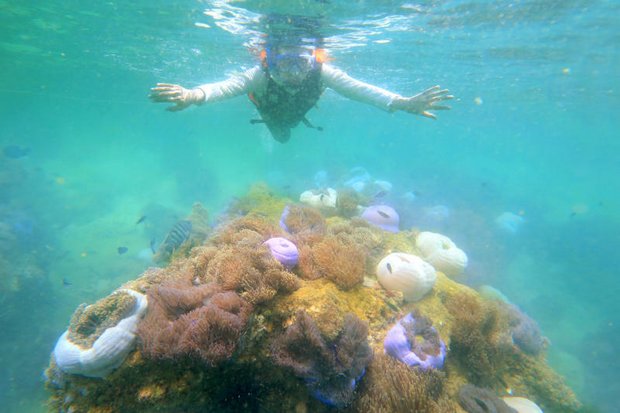
Coral bleaching has been detected at Koh Talu and Koh Leum in Prachuap Khiri Khan province for the first time, and rising water temperatures could make it worse, a marine biologist said.
Department of Marine and Coastal Resources senior biologist Nalinee Thongtham said the department found about 5% of the coral reef, mainly hump corals, has been bleached.
She said sea temperatures are increasing and expected to exceed 30C in some places. If temperatures do not drop, coral bleaching will expand.
In the Andaman Sea, there are reports of colour fading in some coral reefs, according to Ms Nalinee.
She said the strong influence of El Nino last year increased the temperature of seawater in the eastern Pacific. After temperatures dropped there, the mass of warming water moved to the western Pacific.
Further compounding the issue is the high seawater temperature associated with the summer, a significant factor stimulating coral bleaching.
Over 50% of coral reefs in Australia have been suffering from bleaching.
The National Oceanic and Atmospheric Administration (NOAA) in the United States recently forecast that coastal coral in Thailand and the Indian Ocean may begin to bleach this year.
Coral bleaching in Thailand was observed in 1991, 1995, 2003, 2005, 2007 and 2010, with the worst case of the phenomenon in 2010.
At that time, 66.9% of coral reefs in the northern Andaman Sea and 39% in the southern Andaman Sea died from bleaching, according to the marine department.
To limit the impacts, Ms Nalinee said the department has been working with the Department of National Parks, Wildlife and Plant Conservation to possibly close some coral reef sites in the Gulf of Thailand and Andaman Sea if bleaching becomes a crisis.
"By the end of this month, we will know whether things will get any worse. The departments will evaluate the situation before deciding if it is necessary to close the coral reef sites for rehabilitation," she said.
The department has identified 90 sites which have a good capacity to recover from bleaching. Of the sites, some might be closed to promote coral reef expansion, which would help the bleached areas, she said.
These coral reefs may include ones in Satun province, Surin Island in Phangnga province, Koh Chang in Trat province and Koh Kram in Chon Buri province.
Closing the reefs would affect tourism revenue, but no estimate was available.
There are 75,590 rai of coral reef in the Gulf of Thailand, of which 5% are considered to be in fertile condition and 73,364 rai in the Andaman Sea with 6.4% in ideal condition.
Various government agencies say tourism and fishing-related activities are among the key factors killing the coral reefs.